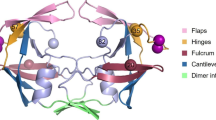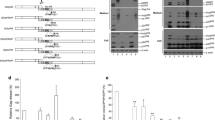Abstract
Human immunodeficiency virus type 1 protease (HIV-1 PR) cleaves two viral precursor proteins, Gag and Gag-Pol, at multiple sites. Although the processing proceeds in the rank order to assure effective viral replication, the molecular mechanisms by which the order is regulated are not fully understood. In this study, we used bioinformatics approaches to examine whether the folding preferences of the cleavage junctions influence their cleavabilities by HIV-1 PR. The folding of the eight-amino-acid peptides corresponding to the seven cleavage junctions of the HIV-1HXB2 Gag and Gag-Pol precursors were simulated in the PR-free and PR-bound states with molecular dynamics and homology modeling methods, and the relationships between the folding parameters and the reported kinetic parameters of the HIV-1HXB2 peptides were analyzed. We found that a folding preference for forming a dihedral angle of Cβ (P1)-Cα (P1)- Cα (P1’)-Cβ (P1’) in the range of 150 to 180 degrees in the PR-free state was positively correlated with the 1/Km (R = 0.95, P = 0.0008) and that the dihedral angle of the O (P2)-C (P2)- C (P1)- O (P1) of the main chains in the PR-bound state was negatively correlated with kcat (R = 0.94, P = 0.001). We further found that these two folding properties influenced the overall cleavability of the precursor protein when the sizes of the side chains at the P1 site were similar. These data suggest that the dihedral angles at the specific positions around the cleavage junctions before and after binding to PR are both critical for regulating the cleavability of precursor proteins by HIV-1 PR.



Similar content being viewed by others
References
Leis J, Baltimore D, Bishop JM et al. (1988) Standardized and simplified nomenclature for proteins common to all retroviruses. J Virol 62:1808–1809
Partin K, Krausslich HG, Ehrlich L et al. (1990) Mutational analysis of a native substrate of the human immunodeficiency virus type 1 proteinase. J Virol 64:3938–3947
Wondrak EM, Louis JM, de Rocquigny H et al. (1993) The gag precursor contains a specific HIV-1 protease cleavage site between the NC (P7) and P1 proteins. FEBS Lett 333:21–24
Louis JM, Dyda F, Nashed NT et al. (1998) Hydrophilic peptides derived from the transframe region of Gag-Pol inhibit the HIV-1 protease. Biochemistry 37:2105–2110
Mervis RJ, Ahmad N, Lillehoj EP et al. (1988) The gag gene products of human immunodeficiency virus type 1: alignment within the gag open reading frame, identification of posttranslational modifications, and evidence for alternative gag precursors. J Virol 62:3993–4002
Gowda SD, Stein BS, Engleman EG (1989) Identification of protein intermediates in the processing of the p55 HIV-1 gag precursor in cells infected with recombinant vaccinia virus. J Biol Chem 264:8459–8462
Krausslich HG, Ingraham RH, Skoog MT et al. (1989) Activity of purified biosynthetic proteinase of human immunodeficiency virus on natural substrates and synthetic peptides. Proc Natl Acad Sci USA 86:807–811
Pettit SC, Moody MD, Wehbie RS et al. (1994) The p2 domain of human immunodeficiency virus type 1 Gag regulates sequential proteolytic processing and is required to produce fully infectious virions. J Virol 68:8017–8027
Lindhofer H, von der Helm K, Nitschko H (1995) In vivo processing of Pr160gag-pol from human immunodeficiency virus type 1 (HIV) in acutely infected, cultured human T-lymphocytes. Virology 214:624–627
Almog N, Roller R, Arad G et al. (1996) A p6Pol-protease fusion protein is present in mature particles of human immunodeficiency virus type 1. J Virol 70:7228–7232
Wiegers K, Rutter G, Kottler H et al. (1998) Sequential steps in human immunodeficiency virus particle maturation revealed by alterations of individual Gag polyprotein cleavage sites. J Virol 72:2846–2854
Pettit SC, Henderson GJ, Schiffer CA et al. (2002) Replacement of the P1 amino acid of human immunodeficiency virus type 1 Gag processing sites can inhibit or enhance the rate of cleavage by the viral protease. J Virol 76:10226–10233
Pettit SC, Everitt LE, Choudhury S et al. (2004) Initial cleavage of the human immunodeficiency virus type 1 GagPol precursor by its activated protease occurs by an intramolecular mechanism. J Virol 78:8477–8485
Pettit SC, Clemente JC, Jeung JA et al. (2005) Ordered processing of the human immunodeficiency virus type 1 GagPol precursor is influenced by the context of the embedded viral protease. J Virol 79:10601–10607
Pettit SC, Lindquist JN, Kaplan AH et al. (2005) Processing sites in the human immunodeficiency virus type 1 (HIV-1) Gag-Pro-Pol precursor are cleaved by the viral protease at different rates. Retrovirology 2:66
Jupp RA, Phylip LH, Mills JS et al. (1991) Mutating P2 and P1 residues at cleavage junctions in the HIV-1 pol polyprotein. Effects on hydrolysis by HIV-1 proteinase. FEBS Lett 283:180–184
Tritch RJ, Cheng YE, Yin FH et al. (1991) Mutagenesis of protease cleavage sites in the human immunodeficiency virus type 1 gag polyprotein. J Virol 65:922–930
Prabu-Jeyabalan M, Nalivaika E, Schiffer CA (2000) How does a symmetric dimer recognize an asymmetric substrate? A substrate complex of HIV-1 protease. J Mol Biol 301:1207–1220
Prabu-Jeyabalan M, Nalivaika E, Schiffer CA (2002) Substrate shape determines specificity of recognition for HIV-1 protease: analysis of crystal structures of six substrate complexes. Structure 10:369–381
King NM, Prabu-Jeyabalan M, Nalivaika EA et al. (2004) Combating susceptibility to drug resistance: lessons from HIV-1 protease. Chem Biol 11:1333–1338
King NM, Prabu-Jeyabalan M, Nalivaika EA et al. (2004) Structural and thermodynamic basis for the binding of TMC114, a next-generation human immunodeficiency virus type 1 protease inhibitor. J Virol 78:12012–12021
Prabu-Jeyabalan M, Nalivaika EA, King NM et al. (2004) Structural basis for coevolution of a human immunodeficiency virus type 1 nucleocapsid-p1 cleavage site with a V82A drug-resistant mutation in viral protease. J Virol 78:12446–12454
Tyndall JD, Nall T, Fairlie DP (2005) Proteases universally recognize beta strands in their active sites. Chem Rev 105:973–999
Fairlie DP, Tyndall JD, Reid RC et al. (2000) Conformational selection of inhibitors and substrates by proteolytic enzymes: implications for drug design and polypeptide processing. J Med Chem 43:1271–1281
Sugita Y, Okamoto Y (1999) Replica-exchange molecular dynamics method for protein folding. Chemical Physics Letters 314:141–151
Pitera JW, Swope W (2003) Understanding folding and design: replica-exchange simulations of “Trp-cage” miniproteins. Proc Natl Acad Sci USA 100:7587–7592
Andrec M, Felts AK, Gallicchio E et al. (2005) Protein folding pathways from replica exchange simulations and a kinetic network model. Proc Natl Acad Sci USA 102:6801–6806
Im W, Brooks CL (2005) Interfacial folding and membrane insertion of designed peptides studied by molecular dynamics simulations. Proc Natl Acad Sci USA 102:6771–6776
Seibert MM, Patriksson A, Hess B et al. (2005) Reproducible polypeptide folding and structure prediction using molecular dynamics simulations. J Mol Biol 354:173–183
Marti-Renom MA, Stuart AC, Fiser A et al. (2000) Comparative protein structure modeling of genes and genomes. Annu Rev Biophys Biomol Struct 29:291–325
Baker D, Sali A (2001) Protein structure prediction and structural genomics. Science 294:93–96
Shirakawa K, Takaori-Kondo A, Yokoyama M et al. (2008) Phosphorylation of APOBEC3G by protein kinase A regulates its interaction with HIV-1 Vif. Nat Struct Mol Biol 15:1184–1191
Maschera B, Darby G, Palu G et al. (1996) Human immunodeficiency virus. Mutations in the viral protease that confer resistance to saquinavir increase the dissociation rate constant of the protease-saquinavir complex. J Biol Chem 271:33231–33235
Zoete V, Michielin O, Karplus M (2002) Relation between sequence and structure of HIV-1 protease inhibitor complexes: a model system for the analysis of protein flexibility. J Mol Biol 315:21–52
Perryman AL, Lin JH, McCammon JA (2004) HIV-1 protease molecular dynamics of a wild-type and of the V82F/I84V mutant: possible contributions to drug resistance and a potential new target site for drugs. Protein Sci 13:1108–1123
Ode H, Neya S, Hata M et al. (2006) Computational simulations of HIV-1 proteases–multi-drug resistance due to nonactive site mutation L90M. J Am Chem Soc 128:7887–7895
Ode H, Matsuyama S, Hata M et al. (2007) Computational characterization of structural role of the non-active site mutation M36I of human immunodeficiency virus type 1 protease. J Mol Biol 370:598–607
Pearlman DA, Case DA, Caldwell JW et al. (1995) AMBER, a package of computer programs for applying molecular mechanics, normal mode analysis, molecular dynamics and free energy calculations to simulate the structural and energetic properties of molecules. Comp Phys Commun 91:1–41
Kollman PA, Massova I, Reyes C et al. (2000) Calculating structures and free energies of complex molecules: combining molecular mechanics and continuum models. Acc Chem Res 33:889–897
Hornak V, Abel R, Okur A et al. (2006) Comparison of multiple Amber force fields and development of improved protein backbone parameters. Proteins 65:712–725
Onufriev A, Bashford D, Case DA (2004) Exploring protein native states and large-scale conformational changes with a modified generalized Born model. Proteins 55:383–394
Tie Y, Boross PI, Wang YF et al. (2005) Molecular basis for substrate recognition and drug resistance from 1.1 to 1.6 angstroms resolution crystal structures of HIV-1 protease mutants with substrate analogs. FEBS J 272:5265–5277
Sayer JM, Liu F, Ishima R et al. (2008) Effect of the active site D25N mutation on the structure, stability, and ligand binding of the mature HIV-1 protease. J Biol Chem 283:13459–13470
Wang J, Cieplak P, Kollman PA (2000) How well does a restrained electrostatic potential (RESP) model perform in calcluating conformational energies of organic and biological molecules? J Comput Chem 29:1693–1698
Labute P (2008) The generalized Born/volume integral implicit solvent model: estimation of the free energy of hydration using London dispersion instead of atomic surface area. J Comput Chem 29:1693–1698
Luthy R, Bowie JU, Eisenberg D (1992) Assessment of protein models with three-dimensional profiles. Nature 356:83–85
Kontijevskis A, Prusis P, Petrovska R et al. (2007) A look inside HIV resistance through retroviral protease interaction maps. PLoS Comput Biol 3:e48
Szeltner Z, Polgar L (1996) Rate-determining steps in HIV-1 protease catalysis. The hydrolysis of the most specific substrate. J Biol Chem 271:32180–32184
Tozser J, Gustchina A, Weber IT et al. (1991) Studies on the role of the S4 substrate binding site of HIV proteinases. FEBS Lett 279:356–360
You L, Garwicz D, Rognvaldsson T (2005) Comprehensive bioinformatic analysis of the specificity of human immunodeficiency virus type 1 protease. J Virol 79:12477–12486
Dogra SK. “Y Scrmabling” from QSARWorld - A Strand Life Sciences Web Resource. Available from: http://www.qsarworld.com/qsar-statistics-y-scrambling.php
Zamyatin AA (1972) Protein volume in solution. Prog Biophys Mol Biol 24:107–123
Prabu-Jeyabalan M, King NM, Nalivaika EA et al. (2006) Substrate envelope and drug resistance: crystal structure of RO1 in complex with wild-type human immunodeficiency virus type 1 protease. Antimicrob Agents Chemother 50:1518–1521
Okimoto N, Tsukui T, Hata M et al. (1999) Hydrolysis mechanism of the phenylalanine-proline peptide bond specific to HIV-1 protease: investigation by the ab initio melecular orbital method. J Am Chem Soc 121:7349–7354
Okimoto N, Tsukui T, Kitayama K et al. (2000) Molecular dynamics study of HIV-1 protease-substrate complex: roles of the water molecules at the loop structures of the active site. J Am Chem Soc 122:5613–5622
Acknowledgments
This work was supported by a Grant-in-Aid for Japan Society for the Promotion of Science (JSPS) Research Fellowships, and a Grant for HIV/AIDS Research from the Ministry of Health, Labor and Welfare of Japan.
Author contributions
Designed the research: H.O. and H.S. Performed the research: H.O. Contributed analytic tools: M.Y. and T.K. Analyzed the data: H.O. Wrote the paper: H.O. and H.S.
Author information
Authors and Affiliations
Corresponding author
Electronic supplementary material
Below is the link to the electronic supplementary material.
ESM 1
(DOC 367 kb)
Rights and permissions
About this article
Cite this article
Ode, H., Yokoyama, M., Kanda, T. et al. Identification of folding preferences of cleavage junctions of HIV-1 precursor proteins for regulation of cleavability. J Mol Model 17, 391–399 (2011). https://doi.org/10.1007/s00894-010-0739-z
Received:
Accepted:
Published:
Issue Date:
DOI: https://doi.org/10.1007/s00894-010-0739-z




